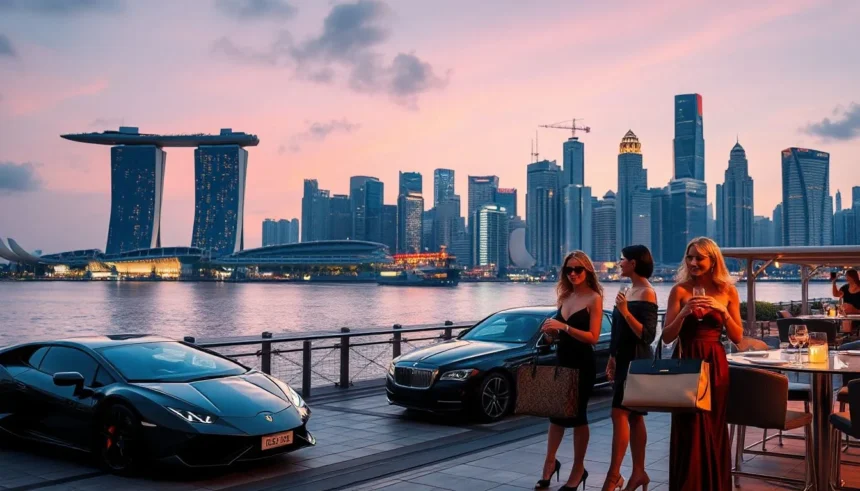Singapore Remains the World’s Most Expensive City for Luxury Spending for the Third Consecutive Year
Introduction
For three years straight, Singapore has held the top spot as the priciest city for buying luxury items. This streak underscores the city’s powerful role in the global luxury market. Meanwhile, the biggest cities like London and Hong Kong still draw high-end shoppers, but Singapore’s edge keeps growing. The world of luxury goods is changing fast, driven by more wealth in Asia. This article explores why Singapore leads in luxury spending and how London and Hong Kong compare. Understanding these trends helps brands target customers better and guides buyers in making smarter choices.
Why Singapore Continues to Lead in Luxury Spending
Economic Factors Contributing to High Luxury Expenditure
Singapore’s economy remains strong. Its gross domestic product (GDP) continues to grow, showing the city’s financial health. Wealthy residents and high-income earners make up a big part of the market. Many have the cash to splurge on luxury brands. Currency strength and tax rules also push prices higher. This makes luxury goods more expensive here than in other cities, boosting overall spending.
Tourism and International Visitors
Luxury tourism plays a big role in Singapore’s spending scene. Tourists from China, the Middle East, and Europe often visit to shop and stay. Their spending adds to the city’s luxury retail numbers. Many high-net-worth individuals (HNWIs) visit Singapore for business or leisure. As they shop, they boost sales in high-end stores and real estate alike. This influx of wealth keeps luxury prices high and shopping halls busy.
Retail and Real Estate Luxury Markets
Luxury real estate in Singapore is booming. Buying high-end homes is a sign of wealth and status. This trend lifts the entire luxury market. The city’s malls and shopping districts keep expanding, welcoming flagship stores from top brands like Louis Vuitton or Gucci. Their presence keeps the prices elevated. Essentially, Singapore’s luxury retail sector is thriving thanks to a mix of wealthy locals, tourists, and a business-friendly environment.
Comparative Analysis: London and Hong Kong’s Luxury Spending Trends
London: A Historical Luxury Hub Facing Market Shifts
London used to be the top destination for luxury shoppers. Its history as a global financial center helped build a strong high-end market. Yet recent events have shifted the scene. Brexit caused currency fluctuations, making some luxury items cheaper or more expensive. Covid-19 also hit tourism, leading to store closures and reduced foot traffic. Still, London’s luxury brands adapt by opening new stores or offering exclusive experiences. The city remains a key player, but its market is now changing faster than ever.
Hong Kong: A Resilient but Challenged Luxury Market
Hong Kong is famous for luxury shopping and high-end spending. It used to be one of the biggest markets worldwide. But ongoing protests and the pandemic shook things up. Many tourists stayed away or canceled trips, hitting retail sales and luxury spend. Still, Hong Kong shows signs of recovery. Wealthy buyers continue investing in real estate, and some brands are shifting their focus to local residents. The city’s ability to adapt keeps it a vital part of the global luxury game.
Key Differences and Similarities
Both London and Hong Kong have seen shifts. London’s market has become more uncertain with political and economic changes. Hong Kong faced more direct challenges from social unrest and the pandemic. Still, both cities have strong local and international buyers. Consumers are more interested in personalized, exclusive experiences. Local policies and global politics influence how much luxury spending happens. Despite hurdles, both are crucial hubs for global luxury brands, each with its own strengths and risks.
Factors That Drive Global Luxury Spending Fluctuations
Impact of Global Economic Conditions
When currencies change or inflation rises, luxury prices can jump. Wealth concentration also fuels higher spending. As more ultra-rich individuals come into focus, demand for top-tier brands grows. Those shifts mean that luxury markets follow the ebb and flow of the world economy.
Technological and Digital Transformation
Online shopping has changed everything. Customers now buy luxury goods on websites or apps, sometimes without leaving home. Virtual shows and exclusive online events become part of the luxury experience. Digital tools help brands reach customers worldwide, making shopping more convenient but also more competitive.
Cultural Shifts and Consumer Preferences
Today’s luxury buyers care more about sustainability. Ethical brands and eco-friendly products are in demand. Younger shoppers from Gen Z or millennials are starting to spend big, bringing new tastes and habits. They want unique, tailored experiences — not just a bag or watch but an emotional connection. Personalization and customization now play big roles in luxury shopping.
Actionable Insights for Luxury Brands and Consumers
Luxury brands must rethink strategies. Create localized experiences that appeal to different markets. For consumers, authenticity matters. Look for stores and brands that align with your values. Use digital channels to explore and find exclusive items. Keep an eye on global news and economic signals. Conditions in one country can quickly impact the entire luxury scene.
Conclusion
Singapore still leads as the most expensive city for luxury spending, and it’s unlikely to lose that spot soon. Its strong economy, vibrant tourism, and thriving real estate market keep prices high. Meanwhile, London and Hong Kong experience their own ups and downs but remain vital parts of the high-end world. Recognizing local differences yet understanding broad trends can help brands and shoppers succeed. Staying informed about economic, social, and political shifts will help everyone make smarter decisions in the ever-changing luxury market. The more you know, the better you can enjoy and invest in these luxury hotspots.

